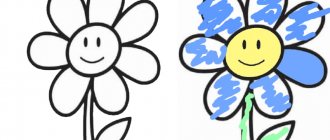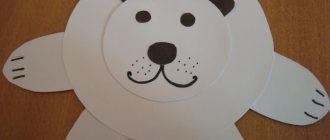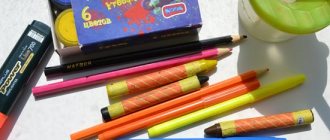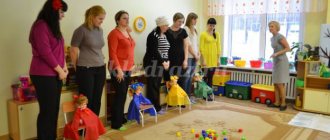The importance of fine motor skills for child development
Much research has been devoted to the importance of fine motor skills for human development. They all confirm that making small movements with the hands and fingers stimulates the speech centers of the brain. And successful mastery of speech, in turn, contributes to the child’s communication skills, successful establishment of social connections and the formation of conceptual thinking.
Finger drawing
In general, fine motor activity is associated with the cognitive development of a child’s psyche. This is especially true for children 3–4 years old, since at this age the child’s social environment and horizons expand sharply, he begins to interact daily not only with parents and close relatives, but also with his peers, teachers, kindergarten workers and other adults.
Reference. “The 3-year-old crisis” or “the crisis of negativism” is an age stage in the development of a child, manifested by such behavioral characteristics as stubbornness, obstinacy, and protest. Successful overcoming of this period is facilitated by the development of the child’s speech skills.
When a child’s wishes do not coincide with his real capabilities, he finds himself in a situation in which he is forced to learn to negotiate. A parent and a three-year-old face the difficult task of reaching a compromise. It is much easier to achieve mutual understanding when the child has sufficient speech and is able to express his needs and experiences.
The help of drawing may not seem obvious at first glance, but scientific research and long-term teaching experience confirm the effectiveness of this method. In addition, the psychotherapeutic effect of drawing has long been known, thanks to which conducting a thematic lesson with elements of art therapy will help a child overcome the tension and anxiety associated with a crisis period.
Drawing techniques for children of the second younger group
There are quite a few types and techniques of drawing available to children aged 3–4 years. Below are the most interesting and useful of them.
Finger drawing
This simple and fun technique is ideal for introducing fine art. It is quite simple to implement, gives the child freedom of action and is easy to master in a playful way. For the first time, you can try leaving fingerprints on paper using different colors. Once the child understands the meaning of this action, you can allow him to draw with his fingers at his own discretion.
Important! The teacher must first demonstrate this method himself. After the child has shown interest, he is invited to do the same. If the baby does not demonstrate readiness, the lesson should be postponed.
Once this technique is mastered, you can use it to create narrative drawings. To do this, before class, outline images of the sun, a balloon, a house or other objects are drawn on sheets of paper with a marker. Then the children are asked to use their fingerprints to fill the space inside the finished drawing.
Drawing with palms and fists
Once the finger technique is mastered, children can easily move on to drawing with their palms. An adult needs to be creative and think through the plot of the drawing in advance. The handprint can be the rays of the sun, some animal, flower, tree or house. After the paint on the paper has dried, eyes, ears, leaves or other elements that make the drawing recognizable are drawn in with felt-tip pens.
Drawing with palms
Drawing with stamps and signets
Drawing stamps can be purchased at art stores or made independently from natural materials, cardboard, foam sponge, cotton swabs, even potatoes or cauliflower. This technique makes a special impression on children due to its simplicity of execution and spectacular results. At the first stage, you can let children master the use of a stamp in a free form, and then offer a plot drawing.
Stamps
Blotography
This method will introduce the child to the properties of paints. Applying watery blots and streaks to the paper will reveal an interesting mixture of colors. At this moment, you can draw the child’s attention to the fact that two different colors, when mixed, can give a third, completely new one. You can also experiment with thickness - apply streaks and splashes first with liquid and then with thicker paint. After the drawing has dried, using felt-tip pens or pencils, you can shape the blots into an image of space, landscape, season (for example, if yellow and red colors predominate - autumn, blue and white - winter).
Blotography
Monotype
An effective technique that creates symmetrical patterns. A sheet of paper is folded in half and paint is applied to one half in the form of blots, or, if the plot is thought out in advance, along the contour outlined in pencil. Then the paper is folded, smoothed with the palm of your hand and straightened. The resulting print is allowed to dry, after which the necessary contours and elements are drawn in with felt-tip pens. It is so easy to depict objects such as a butterfly, an airplane, a book.
Monotype
Dots and lines
For this type of drawing with children 2–4 years old, use pencils or wax crayons. Mastering dots and lines will prepare the child to build more complex compositions from them on a sheet of paper. You can pay attention to different types of lines - straight, wavy, zigzag, and then use them to depict sea waves, hills, mountains on paper. Using the dots in the picture, you can try to depict rain, snow, flowers, sand. In this way, the child is introduced to the landscape and asked to depict spring or winter using simple lines and dots.
Waves
Tracing and painting
Children are given or offered a choice of templates in the form of pets, toys, dishes, and vehicles. The templates are outlined and painted over with paints or pencils.
Information and communication technologies in the educational process
To conduct the lesson you will need the following materials:
- The basis for drawing is paper, cardboard for making small drawings; For finger painting or drawing with your palms, it is convenient to use whatman paper or the back of the wallpaper.
- Colored pencils, markers, crayons, gouache, watercolors, brushes, sippy cups with water.
- Stamps, seals, homemade stamps from scrap materials.
- Oilcloths, sponges, wet wipes, aprons, rags, soap.
Drawing in the younger group requires an individual approach to each student. This is a new and difficult activity for the child, in mastering which he needs constant support and assistance from the teacher. Any criticism should be avoided, regardless of whether the desired result is achieved. At each stage of the lesson, it is necessary to pay attention to each child and help to cope with the difficulties that arise.
Important! At the age of 3–4 years, children can already understand and follow short, understandable instructions, so the introductory and demonstration part of the lesson is conducted by the teacher for the whole group.
GCD for drawing in the second junior group on the topic “Cockerel - golden comb”
Goal: To become familiar with the “Drawing with Palms” technique.
Tasks:
- Learn how to make a palm print on a piece of paper.
- Develop paper orientation.
- Develop creative skills.
- Cultivate a love for animals and empathy for the character.
Demonstration materials:
- illustrations for the fairy tale “The Cockerel is the Golden Comb”;
- audio recording of a fairy tale.
Handouts: gouache, brushes, sponges, napkins, cotton swabs, sippy cups with water, paper, oilcloths, aprons.
Preliminary work:
- listening to an audio recording of the Russian folk tale “Cockerel - the Golden Comb”;
- solving riddles about the cockerel.
| List of professions | Regulatory issuance procedure |
| Builders | signal form; gloves; PPE for face and ears; Vibration reduction products |
| Drivers | mittens; warm suit; safety shoes |
| Loaders | overalls; gloves; jackets; trousers. |
| Sales staff | headscarves; gloves; robes |
| Agricultural employees | gloves; shoes; mittens. |
| Electrical workers | dielectric special gloves; safety shoes; headdress; outerwear; thermal underwear for dielectrics. |
Open mathematical classes in older groups in the form of games
Cockerel
Cockerel
Cockerel
Instructions for making the drawing “Cockerel - golden comb” using the palm painting technique:
- A sheet of paper is placed horizontally in front of the child.
- Using a sponge, the central part of the palm and thumb are painted yellow.
- The remaining fingers are colored red, green, blue and orange.
- The hand should be held in front of you with the thumb up, and the remaining fingers spread wide.
- The palm is pressed firmly onto the paper.
- Use napkins to wipe off the remaining paint from your palms.
- A cotton swab is dipped in black paint and placed in the middle of the thumbprint - this is the eye of the cockerel.
- The clean end of a cotton swab is dipped in red paint and a beard and comb are drawn with a poke.
- The beak is painted on with a thin brush.
- If desired, the drawing is complemented by other elements - sun, grass, roost for a cockerel.
Important! The leading activity of children aged 3–4 years is play, so it is advisable to include it in drawing classes in the 2 ml group.
Card index of games for children 3 years old
A card index of games has been developed for children aged 3 years during drawing classes in kindergarten.
Game "Magic Colors"
Goal: to introduce children to the features of color mixing.
Materials: colored cards, “+”, “-”, “=” cards.
Move: an example is shown, made up of cards: red + blue = purple; green+red=brown.
Children solve them using paints on paper.
Game "Aquarium"
Goal: learn the names of colors.
Material: fish made of cardboard of various colors, cards - aquariums with outline drawings of fish in the corresponding colors.
Progress: according to the teacher’s instructions, children select fish to the contours in the aquarium.
Game "Matryoshka"
Goal: to consolidate knowledge about the main styles of Russian painting.
Move: there are images of nesting dolls on the board. Children take turns trying on their version of a painted sundress.
Game "Duck and Ducklings"
Goal: improve spatial orientation skills.
Materials: cardboard ducks and ducklings, image of a pond.
Progress: the children are given the task of making the path of the duck to the ducklings, and then to the pond.
Game "Winter Fun"
Goal: consolidate knowledge about winter.
Materials: image of a winter landscape, templates for winter clothes and shoes, winter games items.
Progress: with the help of a winter landscape, the teacher updates knowledge about winter. Children are invited to choose from templates items related to winter and winter games: felt boots, mittens, hats, sleds, skates, hockey sticks.
Paper fairy, lesson notes on getting to know the world around you
Summary of an integrated lesson on familiarization with the outside world and paper construction in the second junior group, topic “Paper Fairy”
Author of the lesson: Svetlana Alekseevna Davydova, teacher-methodologist of the highest qualification category.
Goals:
Introduce children to some of the properties of paper (thick - thin, durable) in the process of performing various actions with it (creasing, tearing, twisting). Introduce children to the use of paper in human life. Introduce the following words into the children's active dictionary: paper, paper, durable. Get children interested in working with paper. Develop thinking and fine motor skills of the hands. Cultivate curiosity and thrift.
Equipment:
“Paper Fairy” doll made from various types of paper. Square pieces of paper of different types (napkin, colored paper, Whatman paper, cardboard, candy wrappers). 10 thick sketchbooks. Container with water. Towel. Items made from paper (book, album, napkin, picture, coloring book, toy, newspaper, magazine, cap-mask for theatrical performance, etc.) Equipment for designing from paper.
Progress of the lesson:
Guys, look who's visiting us today. (Showing the doll). This is the Paper Fairy from Paper Land. In this country, everything is made of paper: houses, clothes, transport and everything, everything, everything. Look closely at the Fairy herself. Even she herself is made of... what? From paper. Can you name what kind of paper it is made from? From colored paper, from napkins, from cardboard, from newsprint. In our world, there are also things made of paper. Can you name some of them?
Didactic exercise “What comes from paper”
Children list objects they know that are made of paper.
Attention! Listen to the task: walk around the group room, find and bring one paper object, that is, an object made of paper. Complete the task.
Didactic exercise “Bring a paper object”
The teacher asks each child to name the item brought, using the adjective “paper”.
Now think, can everything in our world be made of paper? Can there be paper houses? Why? Why don’t we make clothes out of paper in our world? Furniture? What about transport? Our houses are built from stone, furniture is made from wood, clothes are made from fabric, and vehicles are made from metal. Because these materials are durable and reliable. We’ll check with you now to see if the paper is durable. We will conduct several experiments with paper.
Paper Crushing Experience
Try crumpling the paper. Is it easy to do? Try to crumple the table at which you are sitting. Happened? Because the wood from which the table is made is strong, but the paper is fragile.
"Tearing Paper" Experience
Try tearing the paper. Is it easy to do? Can you tear the towel? Give it a try. Happened? Why? Because fabric is stronger than paper.
Experiment with water and paper
Place pieces of paper in water. Look, the napkins immediately got wet. Let's try to take them with our hands. What happened? Are they torn? The rest of the paper is thicker than napkins, so it takes longer to soak. We'll look at it again at the end of class. Now let’s conclude: paper is afraid of water. All paper items deteriorate when exposed to water. Paper is a fragile material.
Have you noticed that some paper is easy to crumple, while others are difficult? Is it easy to tear one paper, but difficult to tear another? Show me some scraps of paper that you easily tore? What kind of paper was difficult to tear? What do you think is the reason for this? Thin paper is easier to wrinkle and tear. And thick paper is more difficult to wrinkle and tear.
Dynamic pause “Paper candy wrappers”
We are paper candy wrappers, Sweets were sitting in us. And the kids with a sweet tooth ate the candy together. (Children squat in a circle, holding candy wrappers in their hands. They imitate eating candy)
The wind suddenly came and picked up all the candy wrappers. (They get up and, spinning, wave their arms, then run in all directions)
They spun, flew and sat quietly on the ground. (Squat down)
We'll take all the candy wrappers (Put the candy wrappers in a box)
And we'll put it in the box.
Conversation about paper
The Paper Fairy asks you guys to take care of paper and not tear it or throw it away needlessly. After all, paper is made from trees. To make 10 sketchbooks (display), one small tree had to be cut down. The more paper is made, the fewer trees there are. If you save paper, you will save a lot of trees.
Paper construction “Colored lump balls”
Children crumple colorful napkins into round balls.
Breathing exercises
Children are asked to blow on paper balls. Observe their movement depending on the force with which they are blown.
Blow lightly on the lump, it will move quietly. Blow harder on the lump, it will run more cheerfully.
Paper “Wreath” design
Children roll a long flagellum from a green napkin, then stick balls (flowers) rolled from napkins of different colors onto it. The teacher helps the children roll the flagellum into a ring and secure it (glue it together).
Our meeting with the Paper Fairy is coming to an end. Take a look at our paper in water. What happened to her? You can still use it. Let's play goodbye.
Didactic game “It happens - it doesn’t happen”
The teacher names an object with the adjective “paper,” and the children answer “it happens” or “it doesn’t happen,” depending on whether this object is made of paper.
Paper book Paper chair Paper boat Paper towel Paper shoes Paper coat Paper newspaper
Well, it's time to say goodbye to the Paper Fairy. What will we say goodbye? We will also promise the Fairy to take care of paper and take good care of things made of paper.
Download lesson notes “Paper Fairy”
vospitatel.com.ua





